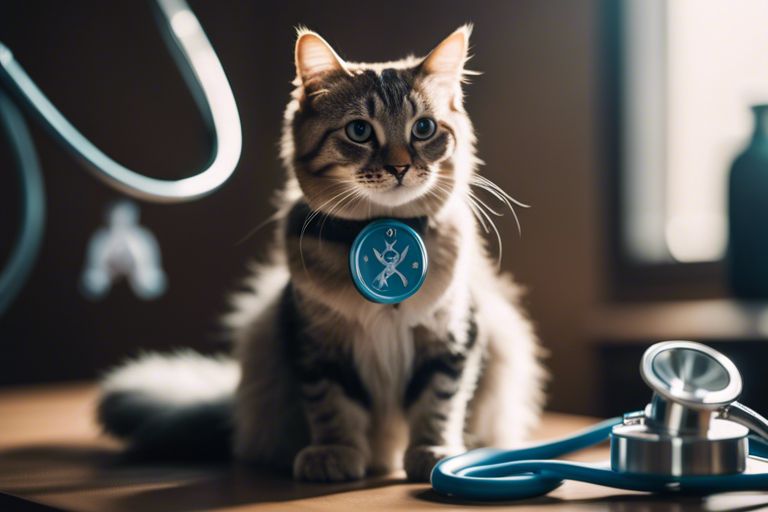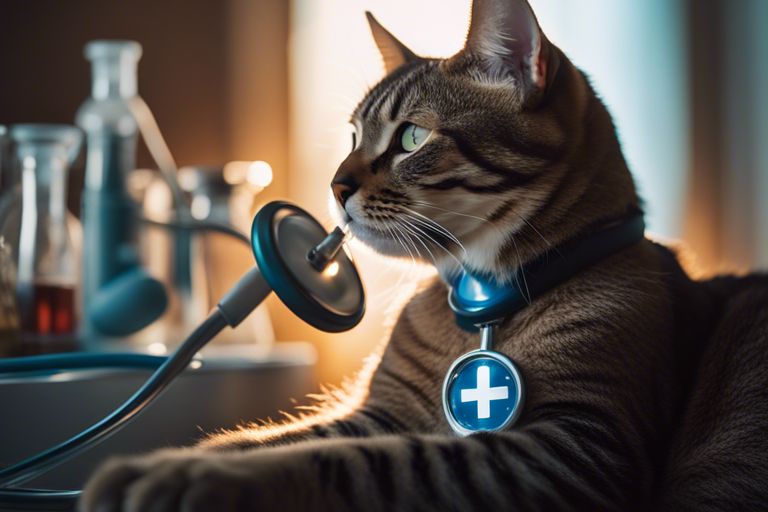Have you ever noticed your feline friend wheezing or coughing? It’s important to be aware of the most common respiratory problems in cats so you can recognize the symptoms and seek proper treatment. Some respiratory issues can be minor, while others can be dangerous and even life-threatening. From simple sneezing to more serious conditions like feline asthma, knowing the signs and seeking veterinary care can make a positive impact on your cat’s health. In this blog post, we’ll cover the most prevalent respiratory problems in cats, their symptoms, and what you can do to keep your feline friend healthy.
Key Takeaways:
- Upper respiratory infections (URIs) are the most common respiratory problem in cats, often caused by viruses such as herpesvirus and calicivirus.
- Asthma is another common respiratory issue in cats, characterized by wheezing, coughing, and difficulty breathing.
- Feline infectious peritonitis (FIP) is a potentially fatal respiratory disease caused by a coronavirus that primarily affects the abdomen, but can also cause respiratory symptoms.
- Pneumonia can occur in cats due to a variety of causes, including bacterial, viral, or fungal infections, and can be serious if left untreated.
- Tumors or growths in the respiratory system can also cause respiratory problems in cats, and may require surgical removal or other treatments.

Common Feline Respiratory Disorders
Obviously, cats can suffer from a variety of respiratory problems, just like humans. It’s important for you to be aware of these issues so you can recognize the signs and seek appropriate treatment for your feline friend. The most common respiratory disorders in cats include respiratory infections, asthma, and pneumonia. These can be caused by viruses, bacteria, allergens, or other irritants.
Upper Respiratory Infections (URIs)
When your cat has a respiratory infection, they may exhibit symptoms such as sneezing, coughing, nasal discharge, and difficulty breathing. URIs are often caused by viruses such as feline herpesvirus and calicivirus. These infections are highly contagious and can spread easily from cat to cat. It’s important to keep your cat’s vaccinations up to date to reduce the risk of respiratory infections. You can learn more about respiratory infections in cats here.
Lower Respiratory Problems
If your cat is experiencing lower respiratory problems, they may have symptoms such as wheezing, coughing, rapid breathing, and lethargy. These issues can be caused by a variety of factors, including infections, asthma, or even lung cancer. It’s important to seek veterinary care if you notice any concerning symptoms in your cat. Your vet can help determine the cause of the problem and create a treatment plan to help your cat breathe easier.
Diagnostic and Management Approaches
Keep in mind that diagnosing and managing respiratory problems in your cat requires a comprehensive approach that involves clinical signs and symptom recognition, diagnostic procedures, and treatment strategies. By understanding each of these aspects, you can ensure the well-being of your feline friend.
Clinical Signs and Symptom Recognition
When it comes to recognizing respiratory problems in your cat, it’s important to pay attention to common clinical signs and symptoms. These may include coughing, wheezing, difficulty breathing, sneezing, nasal discharge, and lethargy. Additionally, watch out for any changes in your cat’s appetite, weight loss, or a decrease in overall activity. If you notice any of these signs, it’s crucial to seek veterinary care promptly.
Diagnostic Procedures
In order to accurately diagnose respiratory problems in your cat, your veterinarian may need to conduct various diagnostic procedures. These may include physical examinations, blood tests, X-rays, and even specialized imaging techniques such as CT scans or MRIs. In some cases, your veterinarian may also recommend collecting samples from the respiratory tract for further analysis. These diagnostic procedures play a vital role in identifying the underlying cause of your cat’s respiratory issues.
Treatment Strategies
Once a diagnosis has been made, your veterinarian will work with you to develop a tailored treatment plan for your cat. This may involve medications, such as antibiotics or anti-inflammatory drugs, to address infections and reduce inflammation. In more severe cases, hospitalization and supportive care may be necessary. It’s important to follow your veterinarian’s instructions carefully and administer any medications as prescribed to ensure the best possible outcome for your cat.
Preventative Measures and Long-term Care
Unlike humans, cats cannot communicate when they are feeling unwell, so it is important to take preventative measures to ensure your feline friend stays healthy. Long-term care and preventative measures can help reduce the risk of respiratory problems in your cat.
Vaccination and Disease Prevention
Vaccinating your cat against common respiratory diseases such as feline herpesvirus and calicivirus is essential in preventing these conditions. These vaccines can significantly reduce the severity and duration of respiratory symptoms if your cat does become infected. It’s important to keep your cat’s vaccinations up to date to ensure they are protected against these potentially serious illnesses.
Environmental Factors and Lifestyle Adjustments
Environmental factors such as cigarette smoke, dusty or moldy environments, and stress can contribute to respiratory issues in cats. To reduce the risk of respiratory problems, make sure your home environment is clean and free from irritants. Additionally, maintaining a stress-free and stimulating environment for your cat can help boost their immune system and overall well-being. Providing a balanced diet and opportunities for exercise can also contribute to a healthy respiratory system.
- Regular cleaning and dusting of your home to reduce irritants
- Avoid exposure to cigarette smoke
- Provide plenty of mental and physical stimulation for your cat
- Feed your cat a balanced diet and ensure they are at a healthy weight
Any adjustments to your cat’s lifestyle should be made gradually to minimize stress and anxiety.
Long-term Management of Chronic Respiratory Conditions
If your cat has been diagnosed with a chronic respiratory condition, such as feline asthma, long-term management is crucial. This may include medication, environmental modifications, and regular check-ups to monitor your cat’s respiratory health. It’s important to work closely with your veterinarian to develop a long-term care plan tailored to your cat’s specific needs.
Owner Education and Responsibilities
After learning about the common respiratory problems that cats may experience, it is important for you as a cat owner to be educated about how to recognize and address these issues. Your cat’s health and well-being depend on your ability to properly care for them, so it is important to be aware of the potential respiratory problems that may arise and what steps you can take to help prevent and manage them.
Recognizing Emergencies and Seeking Timely Help
While it’s crucial to recognize when your cat is experiencing a respiratory emergency, it can sometimes be challenging to know when symptoms warrant immediate attention. If your cat is experiencing severe difficulty breathing, open-mouth breathing, persistent coughing, or wheezing, it is important to seek prompt veterinary care. Additionally, if your cat shows signs of lethargy, lack of appetite, or blue-tinged gums, it is crucial to seek immediate veterinary attention. These signs can indicate a serious respiratory problem that requires urgent medical intervention.
The Role of Regular Veterinary Check-ups
Regular veterinary check-ups are essential for maintaining your cat’s respiratory health. During these visits, your veterinarian can assess your cat’s overall health and monitor for any signs of respiratory problems. Your veterinarian can also provide guidance on maintaining a healthy environment for your cat, which can help prevent respiratory issues. These regular check-ups also provide an opportunity for you to discuss any concerns or changes in your cat’s breathing patterns with your veterinarian. Timely intervention and preventive care can play a significant role in keeping your cat’s respiratory system healthy and functioning optimally.
Conclusion: Most Common Respiratory Problems in Cats
Considering all points, it is important to be aware of the most common respiratory problems that can affect your cat. From infections such as feline viral rhinotracheitis and feline calicivirus, to conditions like asthma and bronchitis, respiratory issues can greatly impact your feline companion’s health and well-being. By being observant of any changes in your cat’s breathing, coughing, or overall demeanor, you can help address these problems early on and seek the appropriate veterinary care. Maintaining a clean and stress-free living environment, as well as providing regular check-ups and vaccinations, will also significantly reduce the risk of respiratory issues in your cat. Remember, your vigilance and proactive approach can make a significant difference in your cat’s respiratory health.
FAQ – Common Respiratory Problems in Cats
Q: What are the most common respiratory problems in cats?
A: The most common respiratory problems in cats include feline upper respiratory infections (URI), feline asthma, and pneumonia. URI is highly contagious and is caused by viruses or bacteria. Feline asthma is characterized by coughing, wheezing, and difficulty breathing, often triggered by allergens or stress. Pneumonia is an infection of the lungs and can be caused by bacteria, viruses, or fungi.
Q: What are the symptoms of respiratory problems in cats?
A: Symptoms of respiratory problems in cats may include sneezing, coughing, nasal discharge, difficulty breathing, wheezing, lethargy, loss of appetite, and fever. If you notice any of these symptoms in your cat, it’s important to seek veterinary attention promptly as respiratory problems can quickly become serious if left untreated.
Q: How are respiratory problems in cats diagnosed and treated?
A: To diagnose respiratory problems in cats, a veterinarian will perform a physical examination and may recommend blood tests, x-rays, and cultures of nasal or throat discharge. Treatment for respiratory problems in cats varies depending on the specific condition but may include antibiotics, antiviral medications, bronchodilators, corticosteroids, and supportive care such as humidification and nebulization. In some cases, management of underlying conditions such as allergies may be necessary to prevent respiratory problems from recurring.

Jayley, a devoted cat enthusiast, also writer for other cat blog as well. She aims to dedicated to providing comprehensive information, insights, and advice on everything you’d ever want to know about our whiskered companions.
